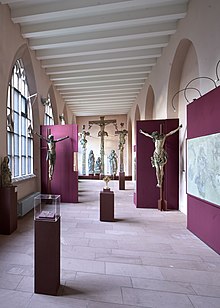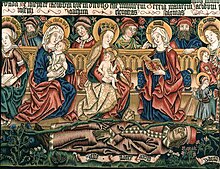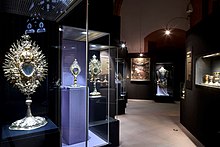Cathedral and Diocesan Museum (Mainz)
The Episcopal Cathedral and Diocesan Museum in Mainz , founded in 1925, houses in its historical rooms - the Hohenstaufen vaulted halls, the two-storey late Gothic cloister and the former chapter rooms - works of art from two millennia that once belonged to the furnishings of the Mainz Cathedral or the churches of the diocese . In addition, there is the cathedral's treasure chamber, which is accessible through the chapter rooms and is located in the former St. Nicholas chapel from the late Gothic period.
Spaces
Vaulted hall / basement
The early and high Middle Ages department is housed in the vaulted halls , which are six meters below today's floor level : a barrel-vaulted room with a span of 8.50 m from the 11th century and a two-aisled complex with groined vaults from around 1200. In the older part the vaulted halls are exhibited works from Roman and early medieval times that come from Mainz or the surrounding area. The pagan consecration altars and stones of the four gods are juxtaposed with early Christian monuments such as the Carolingian “priest stone” (around 800), which exemplify Christianization in the Mainz area. The adjoining younger room houses the collection of stone sculptures from the 13th century, which include major works of early German Gothic. The sculptures and architectural fragments of the former Westlettner (choir screen) from the cathedral, which was created around 1240 by the so-called " Naumburg Master " and his workshop, should be emphasized . In addition to the “Judging Christ” and the “Train of the Blessed and Damned”, the most famous figure of the rood screen is without question the so-called “head with the bandage”, whose painful expression is still impressive today. Other sculptures such as the relief with the stoning of St. Stephanus (around 1270), the head of an archbishop (around 1300) or the majestic "Madonna from Fuststrasse" (around 1250) convey an additional impression of the artistic flourishing of the Mainz archbishopric at the time of the High Gothic.
Cathedral cloister / upper floor
The upper floor of the cathedral cloister, built around 1410, originally served as a scriptorium and for the storage of the cathedral library comprising several 1000 volumes, which was once one of the Seven Wonders of the German Nation. An inscription erected in 1654 above the entrance announced this: “Seven miracles, it is said, the world saw with amazement. The all-consuming time took them away from earth. Of the seven, Germania wanted to preserve and maintain: the choir in Cologne, the clock in Strasbourg, the organ in Ulm, the fair in Frankfurt, the Nuremberg mechanics, the buildings in Augsburg, the library in Mainz. ”When the French-occupied city was bombarded in 1793, the books and cloister went up in flames by allied troops from Austria and Austria. The ribs of the destroyed vault testify to this today.
These rooms have been used by the Cathedral Museum's permanent exhibition since the 1950s. In the new arrangement, in keeping with the time the cloister was built, there are preferably exhibits from the late Middle Ages and the early modern period, i.e. works from the 15th to 16th centuries. Century. In the east wing depictions of Christ from 1000 years are presented, which thematize the different perspectives of the epochs on the Savior. They range from the so-called “Willigiskreuz” (around 1000) to the crucifixion group donated by Hans Backoffen from the Ignazfriedhof in Mainz (1519) to a crucifix that was created under the influence of Surrealism (around 1970).
In the south wing, the focus of the presentation is the famous “Kiedricher Doppelmadonna” (around 1512), which can be viewed at close range for the duration of the restoration of the Kiedricher Michaelskapelle in the south wing of the cloister. Around them unfolds the panorama of an epoch marked by new beginnings in the field of tension between indulgence and Reformation, for which the ambitiously illustrated indulgence certificate of the Mainz brotherhood (around 1484/85) and the crypto portrait of Cardinal Albrecht of Brandenburg as Saint Martin (Simon Franck, 1543) may be mentioned.
Particularly noteworthy are the tapestries from the 15th and 16th centuries presented in a specially set up “dark room”. The “clan carpet” (1501), the “mythical animal” carpet (3rd quarter of the 15th century) and the “coat of arms carpet” by Cardinal Albrecht von Brandenburg are the “highlights” of the collection that will be available in the coming years For conservation reasons, they can be exchanged for other pieces from the extensive holdings of the Cathedral Museum approximately once a year.
Treasury / Nikolauskapelle
For centuries, the Mainz Cathedral Treasury was considered one of the most precious in the West and thus reflected the importance of the largest church province in Central Europe. Due to wars and times of upheaval, only a small part of it survived, which was finally pledged with the end of the old archdiocese. In the course of the 19th century, the cathedral treasure was renewed through the inclusion of liturgical equipment from churches and monasteries of the diocese as well as grave finds that were carried out as a result of extensive renovation work in the cathedral before and after 1900. Today the cathedral treasure again consists of a large number of outstanding goldsmith work and is presented in the late Gothic St. Nicholas Chapel.
The exhibition in the cathedral treasury shows the eventful history of the treasure. Archbishop Willigis' († 1011) chasuble made of Byzantine silk or the high altar of the collegiate church in Halle from the Cranach workshop are just two of the important pieces. In the chapel from the 15th century, masterpieces of goldsmithing are gathered. Their use in the liturgy dictated their set-up: They stand for the seven sacraments and thus for decisive turning points in the life of a Christian. Contemporary goldsmith's work stands next to Romanesque crucifixes and holy water vessels, liturgical books with gothic lids or magnificent baroque ray monstrances. Together with a selection of chalices and other liturgical implements, they give a representative overview of this important genre of Christian art.
Tapestries
The Cathedral Museum has one of the largest collections of Central Rhine tapestries from the 15th and early 16th centuries, but these can only be shown temporarily.
Special exhibitions
In the Cathedral and Diocesan Museum, special exhibitions on ecclesiastical and social topics take place at irregular intervals (selection):
- 2020: "The incomparable precious Carthaus". The first German Carthusian monastery in Mainz .
- 2019/20: Up from the sky ... up close. The figures of the Marian altar and the gargoyles of the cathedral
- 2019: Vulgate. Familiar and strange. 77 contemporary accesses to the Bible
- 2018/19: Heinrich von Meißen called Frauenlob
- 2017/18: With a connoisseur's eye and an eagle eye. Original, fake and copy.
- 2017: Written in gold. Evidence of early medieval written culture in Mainz.
- 2016/17: forever. Modern churches in the diocese of Mainz.
- 2016: Pretty best friends. The collections of the Johannes Gutenberg University in Mainz museums.
- 2016: Escape 2.0. - an odyssey to peace
- 2015/16: cry for justice. Life on the Middle Rhine on the eve of the Reformation.
- 2014 Franz von Kesselstatt . Mainz Canon, diplomat and dilettante.
- 2013 beloved city. Heinz Leitermann draws the old Mainz.
- 2013 splendor of the late Carolingians. Hatto I, Archbishop of Mainz (891–913). From Reichenau to the Mouse Tower.
- 2013 Vis-à-vis with the Domsgickel. A Mainz landmark and its secrets
- 2012 Blissful smile, hellish laughter: Laughter in art and culture of the Middle Ages.
- 2011 The missing cathedral - building history of the cathedral
- 2006 Rabanus Maurus - on the trail of a Carolingian scholar
- 2005 Live again before dying
- 2004 No war is holy - The Crusades
- 2000 dragon, griffin and love people '. Mainz tapestries from the late Gothic period.
- 1998 Hildegard von Bingen 1098–1179
ladder
- 1969–1988: Wilhelm Jung
- 1988–2011: Hans Jürgen Kotzur
- The historian Winfried Wilhelmy has been director of the museum since November 1, 2011 .
literature
- Winfried Wilhelmy, Tino Licht: Written in gold. Evidence of early medieval written culture in Mainz . Schnell und Steiner publishing house, Regensburg 2017, ISBN 978-3-7954-3223-2
- Birgit Kita, Andreas Poschmann: Forever. Modern churches in the diocese of Mainz . Schnell und Steiner publishing house, Regensburg 2016, ISBN 978-3-7954-3193-8
- Winfried Wilhelmy: cry for justice. Life on the Middle Rhine on the eve of the Reformation. Schnell und Steiner publishing house, Regensburg 2015, ISBN 978-3-7954-2965-2
- Gerhard Kölsch: Franz von Kesselstatt. Mainz canon, diplomat and dilettante (= publications of the Episcopal Cathedral and Diocesan Museum Mainz, vol. 5). Mainz 2014, ISBD 978-3-00-046658-8
- Winfried Wilhelmy: Splendor of the late Carolingians. Archbishop Hatto I (891-913) - From the Reichenau to the mouse tower . Schnell und Steiner publishing house, Regensburg 2013, ISBN 978-3795427146
- Winfried Wilhelmy: Blissful smile, hellish laughter: Laughter in art and culture of the Middle Ages . Schnell und Steiner publishing house, Regensburg 2012, ISBN 978-3-7954-2583-8
- Amrei Magdanz: HAP Grieshaber on the 100th birthday. A special exhibition of the Episcopal Cathedral and Diocesan Museum in Mainz, April 4 - September 27, 2009. Edited by Hans-Jürgen Kotzur . Episcopal Cathedral and Diocesan Museum, Mainz 2009, ISBN 978-3-921606-67-4 .
- Diana Ecker: The Mainz Cathedral Museum. History and stories. Verlag der Universitätsdruckerei H. Schmidt, Mainz 2008, ISBN 978-3-935647-42-7 .
- Alexandra König: Cathedral Museum Mainz. Guide to the collection. Edited by Hans-Jürgen Kotzur. von Zabern, Mainz 2008, ISBN 978-3-8053-3910-0 .
- Winfried Wilhelmy: Rabanus Maurus. In the footsteps of a Carolingian scholar. (Catalog for the exhibition in the Episcopal Cathedral and Diocesan Museum in Mainz from February 4 to May 28, 2006). Edited by Hans-Jürgen Kotzur. von Zabern, Mainz 2006, ISBN 3-8053-3613-6 .
- Brigitte Klein, Winfried Wilhemy: No war is sacred. The crusades. Catalog manual for the exhibition from April 2, 2005 to October 2005 in the Mainz Cathedral Museum. Edited by Hans-Jürgen Kotzur. von Zabern, Mainz 2004, ISBN 3-8053-3240-8 .
- Winfried Wilhelmy: dragon, griffin and love people '. Mainz tapestries from the late Gothic period. von Zabern et al., Mainz 2000, ISBN 3-8053-2654-8 (= writings of the Episcopal Cathedral and Diocesan Museum Mainz 1).
- Winfried Wilhelmy, Ines Koring: Hildegard von Bingen. 1098-1179. Edited by Hans-Jürgen Kotzur. von Zabern, Mainz 1998, ISBN 3-8053-2398-0 .
- Winfried Wilhelmy, Mechthild Reinelt: Mainz, February 27, 1945. Contemporary witnesses report. Edited by Hans-Jürgen Kotzur. Schmidt, Mainz 1995, ISBN 3-87439-344-5 .
- Hans-Jürgen Kotzur (Ed.): High Gothic Dialogue. A comparison of the sculptures on the high altars in Marienstatt and Oberwesel. Werner, Worms 1993, ISBN 3-88462-106-8 .
- The organ as a sacred work of art. Volume 2: Friedrich W. Riedel: The organ as a sacred work of art. Catalog of the special exhibition of the Episcopal Cathedral and Diocesan Museum Mainz from October 9, 1992 to October 31, 1993. Edited by Ingobert Jungnitz. Episcopal Ordinariate, Dept. Public Relations, Mainz 1992 (= New Yearbook for the Diocese of Mainz 1991/92, ISSN 0720-2024 ).
- Wilhelm Jung : Mainz. Guide to the Episcopal Cathedral and Diocesan Museum. Hans Krach, Mainz 1971.
Web links
- Episcopal Cathedral and Diocesan Museum
- Object collection of the Episcopal Cathedral and Diocesan Museum on museum-digital
Individual evidence
- ↑ Dilettante according to old meaning in FAZ of August 28, 2014, p. 40.
- ↑ Press Office of the Diocese of Mainz Press release from May 26, 2011: Dr. Winfried Wilhelmy becomes director of the Mainz Cathedral Museum tob (MBN) , accessed on March 28, 2016.
Coordinates: 49 ° 59 ′ 54.3 " N , 8 ° 16 ′ 28.4" E







